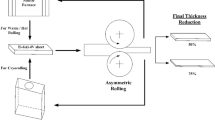Abstract
The Von Mises or perhaps the Tresca criterion is adequate for predicting the onset of yielding under combined stress loading for isotropic materials. However, this prediction is not so straight forward for anisotropic materials in which the magnitude of tensile and compressive yield stresses are different along the different orientations. Such directionality in yield behavior of anisotropic materials may strongly depend on the nature and degree of crystallographic texture. Texture driven yield surfaces are the representatives of the states of plane stress (tension–tension, tension–compression and compression–compression) in thin wall tube by externally applied forces and internal pressure. The applications of yield surfaces are far too wide and particularly have direct relevance to the metal forming, such as cold rolling. A simple procedure based on Knoop microhardness measurements has been proposed in the literature for determining the plane stress yield surface of the sheet materials. In the present study, an attempt has been made to describe this technique and the procedure to determine the yield locus using Knoop microhardness indenter and compare the yield surface anisotropy determined with the experimentally observed tensile properties in the in-plane directions and thus establish the usefulness of this technique in case of a cold rolled and solution treated Nimonic-263 alloy sheet of 1.0 mm thickness in solution treated condition.










Similar content being viewed by others
References
Donachie M J, Superalloys, American Society for Metals (1984).
Sims C E, Superalloys II, Wiely Interscience, New York (1987).
Bradley E F, Superalloys: A Technical Guide, ASM International (1988).
McLean M, Webster G A, Nabarro F R N, and Cottrel A, Phil. Trans. Royal Soc. London A 351 (1995) 419.
Richard J A, and Richard L K, Adv. Mater. Proc 164 (2006) 19.
Kuo V W C, and Starke E A, Metall Trans A 16A (1985) 1089.
Eswara Prasad N, Doctoral Thesis, Banaras Hindu University, Varanasi, India (1993).
Singh A K, Saha G G, Gokhale A A, and Ray R K, Metall Mater Trans A 29A (1998) 665.
Jata K V, Panchandeeswaran S, and Vasudevan A K, Mater Sci Eng A257 (1998) 37.
Dieter G E, Mechanical metallurgy, SI Metric Edition, McGraw Hill Book Co, London (1988).
Hill R, Proc Royal Soc London A193 (1948) 281.
Wheeler R G, and Ireland D R, Electrochem Technol 4 (1966) 313.
Knoop F, Peters C G, and Emerson W B, J Res Natl Bur Stand 23 (1939) 39.
Lee D, and Backofen W A, Trans AIME 235 (1966) 1696.
Schultz L G, J Appl Phys 20 (1949) 1030.
ASTM Standard E-8, Standard test method for tension testing of metallic materials, ASTM International, West Conshohecken, PA (2004).
Ankamma K, Eswara Prasad N, Singh A K, and Chandra Mohan Reddy G, In-plane anisotropy in tensile properties and yield locus in cold rolled Nimonic-263 alloy sheet, To be submitted.
Lee D, Science of hardness testing and its research applications, ASM International, Metal Park, Ohio (1973) 147.
Acknowledgments
The authors are grateful to Shri M. Raghavaiah, Former General Manager, Midhani for his help in procuring the material. Thanks are due to Dr. G.Malakondaiah, Outstanding Scientist and Director DMRL for his permission to use the facilities at DMRL. The authors also would like to thank Shri NB Jagtap for his kind help in the conduct of microhardness measurements. One of the author (KA) is grateful to Professor K Sudhakar Reddy, Head, Mechanical Engineering Department and Professor P Linga Reddy, Director, MGIT for their kind encouragement and support; particularly, for the permission to spend long hours at DMRL to conduct these studies.
Author information
Authors and Affiliations
Corresponding author
Rights and permissions
About this article
Cite this article
Ankamma, K., Singh, A.K., Prasad, K.S. et al. Yield Locus of a Cold Rolled and Solution Treated Nimonic-263 Alloy Sheet, Determined Using Asymmetrical Knoop Micro Hardness Indenter. Trans Indian Inst Met 67, 531–539 (2014). https://doi.org/10.1007/s12666-013-0359-2
Received:
Accepted:
Published:
Issue Date:
DOI: https://doi.org/10.1007/s12666-013-0359-2




